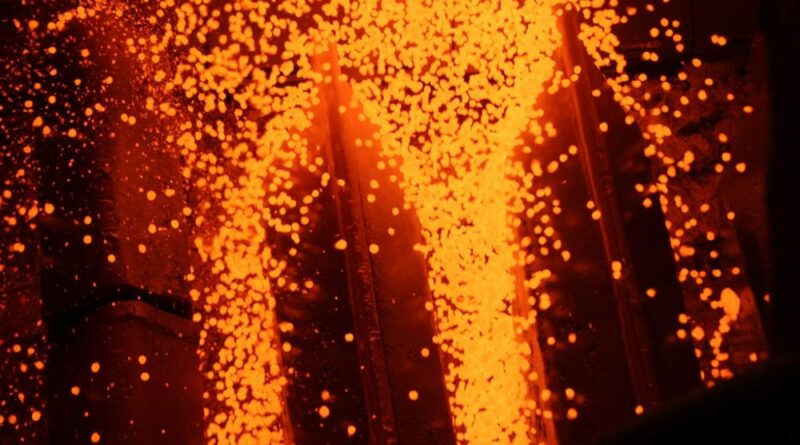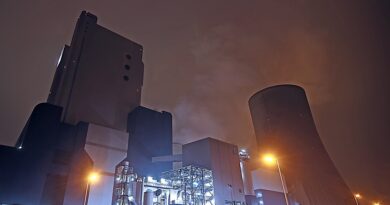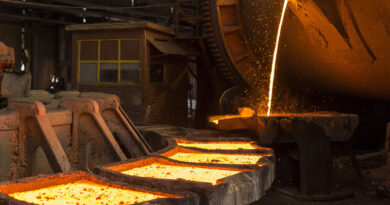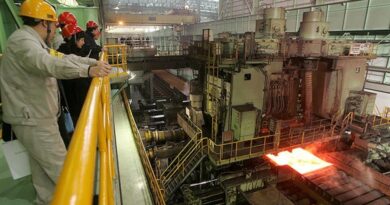Tsodilo Resources to produce DRI using Botswana coal for steel generation
TORONTO, ONTARIO – Tsodilo Resources has provided an update on its wholly owned Xaudum Iron Project. The Company has entered into a research collaboration endeavor with the Department of Chemical, Materials and Metallurgical Engineering at the Botswana International University of Science and Technology (BIUST) and Morupule Coal Mine (MCM) to undertake metallurgical studies with respect to the potential of generating a Pellet Feed and Direct Reduced Iron (DRI) product from the Xaudum Iron Formation (XIF) utilizing its magnetite and MCM’s coal as a reductant. Commercially, these high-grade pellets and DRI product would be used to produce steel within Botswana, the region and internationally.
There is currently a fundamental shift under way within the steel industry with steel producers under pressure to reduce their carbon footprint and produce steel with lower carbon emissions. Carbon emissions (CO2) account for around 80% of greenhouse gas emissions (GHG), where the steel making market contributes to roughly 6% of global CO2 emission. Major corporations including steel producers are focusing on decarbonizing as they target carbon neutrality (Fan and Friedmann, 2021). Climate change issues globally and smog lowering related steel mill curbs on sintering and coal usage in China in particular have focused investors towards projects with higher-grade iron content driving the change that is occurring in the type of iron ore consumed by steel mills from lower-grade energy intensive fines that require sintering towards higher-grade ores and steel making products such as pellet feed and DRI materials.
Blast furnace – basic oxygen furnace (BF-BOF) dominate production but are particularly stubborn to decarbonization technology. Direct reduced iron to electric arc furnace (DRI-EAF) production is growing and has far better decarbonization potential. Emission controls and demand for less carbon intensive steel production will become the norm and steel producers demands for DR quality pellet feed will continue to increase. This shift represents significant opportunities for high-grade magnetite projects like the XIF project.
The Company’s Metallurgical results show that the XIF magnetite product is expected to be a premium high-grade product containing +67% iron magnetite that will be ideal pellet feed material. This quality grade will place the XIF in the top 4-5% of producers in the world by Fe grade. High-grade magnetite pellet feeds at 67% Fe and above have been shown to lower GHG emissions compared to standard feed of 62% iron hematite fines (Herbertson and Strezov, 2011). The collaboration study with BIUST and MCM will identify if the XIF magnetite can be further beneficiated to a pellet feed and upgraded to a DRI pellet or similar product using Botswana coal as the reductant. MCM coal has proven to be a viable substitute for reductants in metalliferous ores processing, hence the confidence that it can be viable in the DRI process. This DRI product can then be used to produce steel in electric arc furnaces in Botswana, the region and international markets.
High-grade concentrates and pellets of 67% Fe, such as the XIF products, offer a net environmental benefit over its life-cycle compared to classic lower grade, Direct Shipping Ores (DSO) ~62% Fe hematite fines, by saving carbon emissions in steel production. Where this carbon saving is derived from the inherent differences in the chemical make-up of magnetite vs. hematite, where magnetite is exothermic (adds heat to the reaction); has a higher iron content (higher grade); lower impurities; and, reduces fluxing. High-grade ores over 65% Fe currently command larger price premiums over standard ores (62% Fe) resulting in higher margins for suppliers of high-grade products. The current global drive for lower emission steel production results in steel producers dramatically increasing their demand for these high-grade ores. Converting to pellets and DRI only increases the benefits over sinter feed, as pellets are of uniform size melt at a more equal rate which significantly reduce the time, energy and as such the resultant emissions to produce steel. There will likely be a significant under supply of high purity pellet feed as demand for these high-end materials increases dramatically by steel producers looking to reduce emission output. This demand increase for these high-end materials will also include steel mills that use DRI products as contemplated by the Company. This continued shift towards low emission steel globally means that the high- grade XIF magnetite project is uniquely placed to meet these emerging markets.
The business case for generating pellet feed, DRI products, and low emission steel from the XIF magnetite is just one of the scenarios that are to be evaluated in the Company’s current Preliminary Economic Assessment (PEA).
Tsodilo’s Chairman and CEO, James M. Bruchs, commented “We are excited by this research collaboration with BIUST and MCB to evaluate the capabilities of generating pellet feed and DRI products for low emission steel production from the XIF magnetite. This extra level of beneficiation within Botswana will create added value and benefits in the form of increased revenue and employment for Botswana. This is just one scenario option amongst several that our PEA will evaluate. The PEA will be a road map for the development of the Xaudum Iron Formation towards production”.
About Botswana International University of Science and Technology (BIUST)
The Botswana International University of Science and Technology is a Government of Botswana supported institution established as a research-intensive University that specializes in Engineering, Science and Technology at both undergraduate and graduate (Master’s and Doctoral) levels. It aims to increase competitiveness, economic growth and sustainable development; address the shortage of skilled scientists and technologists; increase movement of skilled people across national and boundaries international boundaries; stimulate research, innovation, and technology transfer; improve society’s aspirations to improve health, wealth and well-being; address increased demand for access to tertiary education; and enable a more competitive and innovative tertiary education sector.
The University is a national strategic initiative that is intended to serve as one of the key platforms for transforming Botswana’s economy and because of its research emphasis, BIUST works with the private sector to meet emerging skills needs of the industry, as well as identifies challenges that can be solved through applied research. (www.biust.ac.bw).
About Morupule Coal Mine (MCM)
Morupule Coal Mine (initially known as Morupule Colliery) was established in 1973 by Anglo American. MCM is currently 100% owned by the Minerals Development Company Botswana (MDCB), itself 100% owned by the government of the Republic of Botswana.
MCM operates a 3 million tonnes per annum (mtpa) mine within a 4 billion tonne classified semi-bituminous thermal coal resource in a fairly favorable geological setting. Current activities exploit reserves of in situ cv of 22-23MJ/kg (adb), supplying mine mouth power plants and other customers. The mine operates its own railway siding that links into the national rail line which transports products to the north and south of the country and into the SADC region. MCM coal has proven to be a viable substitute for reductants in metalliferous ores processing, hence the confidence that it can be viable in the DRI process (www.mcm.co.bw).
Overview
Preliminary work on the Xaudum Iron project has defined a CIM compliant Inferred Mineral Resource Estimate of 441 million tonnes (Mt) with an average grade of 29.4% Fe, 41.0% SiO2, 6.1% Al2O3 and 0.3% P for the Block 1 magnetite XIF. Block 1 is a fraction of the potential XIF magnetite resource.
An extrapolated exploration target has defined the XIF to be in the order of 5 to 7 billion tonnes at 15-40% Fe. This exploration target was generated by inversion modelling of ground magnetic geophysical data which was compared and moderated to volumes from drilling data within Block 1 and its potential quantity and grade is conceptual in nature.
To date, there has been insufficient exploration to define a mineral resource other than in Block 1 and it is uncertain if further exploration will result in the target being delineated as a mineral resource.
About the XIF Project
- the project is located in the North-West District of Botswana and is proximate to the Namibian boarder and lies thirty (30) miles from the town of Divundu in Namibia. The Trans Caprivi Railway (TCR) line linking Zambia and Namibia is planned to pass through Divundu providing access to Walvis Bay, Namibia’s deep-sea port. The project is also located within forty-three (43) miles of the proposed Mucusso line to Angola’s Namibe Port;
- preliminary work on the Xaudum Iron project has defined a CIM compliant Inferred Mineral Resource Estimate of 441 million tonnes (Mt) with an average grade of 29.4% Fe, 41.0% SiO2, 6.1% Al2O3 and 0.3% P for the Block 1 magnetite XIF;
- Block 1 is a fraction of the potential XIF magnetite resource. An extrapolated exploration target has defined the XIF to be in the order of 5 to 7 billion tonnes at 15- 40% Fe. This exploration target was generated by inversion modelling of ground magnetic geophysical data which was compared and moderated to volumes from drilling data within Block 1 and its potential quantity and grade is conceptual in nature. To date, there has been insufficient exploration to define a mineral resource other than in Block 1 and it is uncertain if further exploration will result in the target being delineated as a mineral resource. See, Press Release of 9/14/2014on the Company’s website for further details;
- metallurgical magnetic separation results (Davis Tube Recovery) show an average concentrate of 67.2% Fe, 4.2% SiO2, 0.5% Al2O3, 0.07% P is obtained at P80 grind size of 80 microns, although higher grades are possible at finer P80’s;
- further exploration will be focused on Block 2 where the Company expects an increase in the resource;
- the XIF Project is a potential large and long-life Tier 1 mining project;
- the PEA will evaluate a number of options for development of the project at a variety of scales including:
- non-traditional but potentially profitable small-scale startup mining production options such as Ferrosilicon (FeSi) production from a magnetite concentrate,
- mid-size scenarios, whereby magnetite concentrate would be processed through a concentrator and transported to railhead and onto port facilities;
- large-scale mining options where full-scale mining would produce a magnetite concentrate processed by a concentrator plant with further potential modification to a pellet which would then be transported to port facilities;
Botswana has significant coal reserves which can be a major advantage for the Xaudum Iron project, allowing for coal to be used in the beneficiation process to generate iron products such as iron pellets, sponge iron, pig iron, and also steel; and,
the project would represent the first iron deposit to be considered for development in Botswana. Gcwihaba has identified the project as having the potential to positively impact the future economy of Botswana as the country looks to diversify its economy, and help Botswana to reach its goal of moving away from a dependence on diamond revenues.




